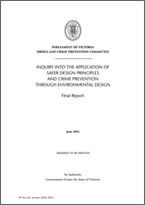 Parliament of Victoria Drugs and Crime Prevention Committee
Parliament of Victoria Drugs and Crime Prevention Committee
Sinopse: Crime Prevention through Environmental Design is an internationally recognised means of reducing both the incidence and the fear of crime through the design and effective use of the built environment. The concept of Crime Prevention through Environmental Design (CPTED) has been influential in the development of the Safer Design Guidelines for Victoria, the leading ‘designing out crime’ framework in operation in Victoria. In fact the Safer Design Principles contained in the Guidelines document are taken directly from the key elements of CPTED theory. The Safer Design Guidelines for Victoria also extend the use of the CPTED concept not only in promoting awareness of crime as a design issue but providing for ways in which good design can promote healthier, more sustainable and ‘liveable’ communities.
Despite the inherent worth of the Guidelines and the principles that underpin them, concern has been expressed about the extent to which they have been used by local government planners and the private development industry. Despite the Safer Design Guidelines for Victoria and their principles having been in place for eight years, there has been no evaluation of the Guidelines or their implementation and application, particularly by local government. Nor has the impact of these guidelines been thoroughly investigated.
As such the Terms of Reference for this Inquiry was to examine the extent to which CPTED and the Safer Design Guidelines/Principles are incorporated into planning and building in Victoria by both local governments and the planning industry.
During the course of the Inquiry, the Committee accepted eight written submissions and heard from 87 witnesses both in Australia and New Zealand. The Committee also commissioned the Sydney Institute of Criminology, University of Sydney to design, conduct and analyse a survey of all local Government municipalities in Victoria to gauge the extent to which local governments incorporate the Safer Design Guidelines for Victoria in their local planning. The success of the survey was reflected in the participation of 97% of local government authorities. Their responses and the analysis of the survey results is extensively discussed in Chapter 9 of this Report. On behalf of the Committee, I would like to thank Garner Clancey and his research team from the Sydney Institute of Criminology and acknowledge his valuable contribution to the Report.
